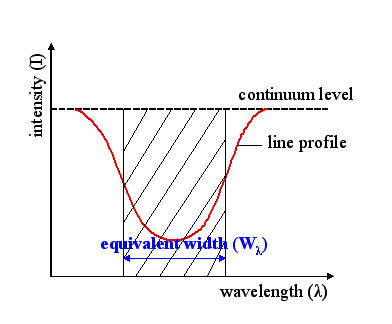Equivalent width on:
[Wikipedia]
[Google]
[Amazon]
 The equivalent width of a
The equivalent width of a
Equivalent Width in the SAO Encyclopedia of Astronomy
Emission spectroscopy Astrochemistry
 The equivalent width of a
The equivalent width of a spectral line
A spectral line is a dark or bright line in an otherwise uniform and continuous spectrum, resulting from emission or absorption of light in a narrow frequency range, compared with the nearby frequencies. Spectral lines are often used to ident ...
is a measure of the area of the line on a plot of intensity versus wavelength
In physics, the wavelength is the spatial period of a periodic wave—the distance over which the wave's shape repeats.
It is the distance between consecutive corresponding points of the same phase on the wave, such as two adjacent crests, tr ...
in relation to underlying continuum level. It is found by forming a rectangle with a height equal to that of continuum emission, and finding the width such that the area of the rectangle is equal to the area in the spectral line. It is a measure of the strength of spectral features that is primarily used in astronomy
Astronomy () is a natural science that studies celestial objects and phenomena. It uses mathematics, physics, and chemistry in order to explain their origin and evolution. Objects of interest include planets, moons, stars, nebulae, g ...
.
Definition
Formally, the equivalent width is given by the equation Here, represents the underlying continuum intensity, while represents the intensity of the actual spectrum (the line and continuum). Then represents the width of a hypothetical line which drops to an intensity of zero and has the "same integrated flux deficit from the continuum as the true one." This equation can be applied to either emission orabsorption
Absorption may refer to:
Chemistry and biology
*Absorption (biology), digestion
**Absorption (small intestine)
*Absorption (chemistry), diffusion of particles of gas or liquid into liquid or solid materials
*Absorption (skin), a route by which s ...
, but when applied to emission, the value of is negative, and so the absolute value is used.
In other words, if the continuum level is constant and the area under/above the emission/absorption line (compared to the continuum) is (the integral above), then (further highlighting the continuum-level dependence). Therefore, for a fixed line strength (), the equivalent width will be smaller for a brighter continuum.
This analogy can help in a better physical interpretation: imagine the plot showing your monetary savings (or flux in a spectrum; on the vertical axis), as a function of time (or wavelength in a spectrum, on the horizontal axis). When you don't have any spending (continuum), your saving rate as a function of time is relatively flat and may even have a slope (if your saving rate is increasing or decreasing). In this plot, making a purchase of something expensive is like an absorption line (it will momentarily bring down your saving rate). The "equivalent time" of that purchase is the "time" it takes for your continuum savings to replace that purchase in your bank account. In this analogy, the same purchase will have a lower "equivalent time" for someone who can save more than you (that person's "continuum" level is higher, so the "equivalent time" for replacing its value in their bank account is less). Similarly, we judge the strength of the emission/absorption line, ''in relation'' to the continuum level surrounding it, through the Equivalent Width.
Applications
The equivalent width is used as a quantitative measure of the strength of spectral features. The equivalent width is a convenient choice because the shapes of spectral features can vary depending upon the configuration of the system which is producing the lines. For instance, the line may experienceDoppler broadening
In atomic physics, Doppler broadening is broadening of spectral lines due to the Doppler effect caused by a distribution of velocities of atoms or molecules. Different velocities of the emitting (or absorbing) particles result in different Do ...
due to motions of the gas emitting the photons. The photons will be shifted away from the line center, thus rendering the height of the emission line a poor measure of its overall strength. The equivalent width, on the other hand, "measures the fraction of energy removed from the spectrum by the line," regardless of the broadening intrinsic to the line or a detector with poor resolution. Thus the equivalent width can in many conditions yield the number of absorbing or emitting atoms.
For example, measurements of the equivalent width of the Balmer alpha transition in T Tauri star
T Tauri stars (TTS) are a class of variable stars that are less than about ten million years old. This class is named after the prototype, T Tauri, a young star in the Taurus star-forming region. They are found near molecular clouds and ide ...
s are used in order to classify individual T Tauri stars as being classical or weak-lined. Also, the equivalent width is used in studying star formation
Star formation is the process by which dense regions within molecular clouds in The "medium" is present further soon.-->interstellar space
in Lyman alpha
The Lyman-alpha line, typically denoted by Ly-α, is a spectral line of hydrogen (or, more generally, of any one-electron atom) in the Lyman series. It is emitted when the atomic electron transitions from an ''n'' = 2 orbital to the gro ...
galaxies
A galaxy is a system of stars, stellar remnants, interstellar gas, dust, dark matter, bound together by gravity. The word is derived from the Greek ' (), literally 'milky', a reference to the Milky Way galaxy that contains the Solar System ...
, as the equivalent width of the Lyman alpha line is related to the star formation rate in the galaxy. The equivalent width is also used in many other situations where a quantitative comparison between line strengths is needed.
References
{{reflistExternal links
Equivalent Width in the SAO Encyclopedia of Astronomy
Emission spectroscopy Astrochemistry